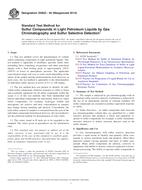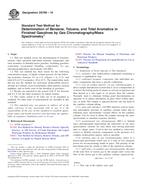We need your consent to use the individual data so that you can see information about your interests, among other things. Click "OK" to give your consent.
ASTM D873-12
Standard Test Method for Oxidation Stability of Aviation Fuels (Potential Residue Method)
STANDARD published on 1.6.2012
The information about the standard:
Designation standards: ASTM D873-12
Note: WITHDRAWN
Publication date standards: 1.6.2012
SKU: NS-39558
The number of pages: 4
Approximate weight : 12 g (0.03 lbs)
Country: American technical standard
Category: Technical standards ASTM
The category - similar standards:
Annotation of standard text ASTM D873-12 :
Keywords:
aviation fuels, gum (insoluble, soluble, potential), oxidation stability, potential residue, total potential residue, ICS Number Code 75.160.20 (Liquid fuels)
Additional information
| Significance and Use | ||||||||||
|
5.1 The results (of these tests) can be used to indicate storage stability of these fuels. The tendency of fuels to form gum and deposits in these tests has not been correlated with field performance (and can vary markedly) with the formation of gum and deposits under different storage conditions. |
||||||||||
| 1. Scope | ||||||||||
|
1.1 This test method2 covers the determination of the tendency of aviation reciprocating, turbine, and jet engine fuels to form gum and deposits under accelerated aging conditions. (1.2 The accepted SI unit of pressure is the kilo pascal (kPa); the accepted SI unit of temperature is °C. 1.3 WARNING—Mercury has been designated by many regulatory agencies as a hazardous material that can cause central nervous system, kidney and liver damage. Mercury, or its vapor, may be hazardous to health and corrosive to materials. Caution should be taken when handling mercury and mercury containing products. See the applicable product Material Safety Data Sheet (MSDS) for details and EPA’s website—http://www.epa.gov/mercury/faq.htm—for additional information. Users should be aware that selling mercury and/or mercury containing products into your state or country may be prohibited by law. 1.4 This standard does not purport to address all of the safety concerns, if any, associated with its use. It is the responsibility of the user of this standard to establish appropriate safety and health practices and determine the applicability of regulatory limitations prior to use. |
||||||||||
| 2. Referenced Documents | ||||||||||
|
Similar standards:
Historical
15.1.2014
Historical
1.6.2014
Historical
1.12.2012
Historical
1.5.2010
Historical
15.4.2012
Historical
1.5.2010
We recommend:
Technical standards updating
Do you want to make sure you use only the valid technical standards?
We can offer you a solution which will provide you a monthly overview concerning the updating of standards which you use.
Would you like to know more? Look at this page.



 ASTM D5623-94(2014)..
ASTM D5623-94(2014).. ASTM D5705-14
ASTM D5705-14 ASTM D5708-12
ASTM D5708-12 ASTM D5769-10
ASTM D5769-10 ASTM D5771-12
ASTM D5771-12 ASTM D5773-10
ASTM D5773-10
 Cookies
Cookies
